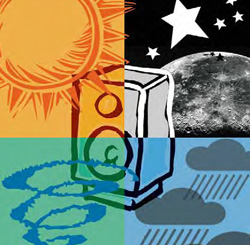
Admittedly, the physical aspects of using delayed systems are a pain.
Obscured sightlines, audio feeds, power availability and extra setup and teardown time add expense and complexity to the production.
But we can minimize the inconvenience. Because air absorption doesn’t affect low frequencies as much as higher ones, we can skip the subwoofers, and in some cases, even the low-frequency cabinets in the delayed system.
This cuts the size and power requirements way down. And co-locating a delayed source with the mix position cuts down on audio and power feed issues.
Delay is an ideal application for some of the new smaller-format line array systems. They provide plenty of horsepower in a small footprint preserving sight lines. Alternatively, smaller full-range cabinets can be deployed from the “B” system.
How far from the main clusters should delays be positioned? Sometimes this is governed by physical considerations, and sometimes sound pressure level (SPL) limits are set by the venue in consideration of the surrounding communities.
If SPL is being measured at front of house, the main system may be operating at a fairly low level, keeping the delayed systems from being very far from the stage. A modeling program, or simple math and the inverse square law (or just the inverse law in the case of line arrays) can be used to determine what the acceptable level decrease is before the signal needs to be re-amplified.
Always keep in mind that the extra losses described are over and above the theoretical losses. If a show is being staged in a calm, high-humidity area, you may not have to allow for much environmental loss. But if a show is held in a windy desert, watch out!
Show The Arrivals
How do we determine the correct amount of signal delay to apply? In my view, measuring the actual time difference is the best way to go.
Use (Rational Acoustics) Smaart or (Gold-Line) TEF to produce an impulse response or an Energy Time Curve (ETC). This should clearly show the arrivals from the main system and the delayed stacks, and enable you to use the cursors to give you a delay number.
If you don’t have one of these tools at your disposal, just do the math. At 70 degrees F, at sea level, the speed of sound is 1,130 feet per second, or about .88 ms per foot. If you know the distance, you can determine the time delay.
Many audio engineers like to take advantage of the Haas (or precedence) effect. The human ear localizes on sound based on both time of arrival and frequency content. The earliest sound – and/or – the sound with the most high-frequency content establishes the perceived direction that the sound is coming from.
The human ear also integrates sounds that arrive within about a 20 ms window, and this is called the Haas zone. In other words, within this time frame, the ear does not perceive separate arrivals.
Thus the audience can be “fooled” into believing that all sound is coming from the stage system by delaying the signal slightly beyond the acoustically correct setting, and by slightly rolling off higher frequencies. This is called localization. You know you’ve done it right if people are saying that the delayed loudspeakers aren’t working when you know they are.
And don’t forget, the speed of sound changes with temperature. If the environment has large temperature swings reset your delays as close to show time as possible.
Now if we could just get it to stop raining.
Bruce Main has been a systems engineer and front of house mixer for more than 30 years, and has also built, owned and operated recording studios and designed and installed sound systems.

